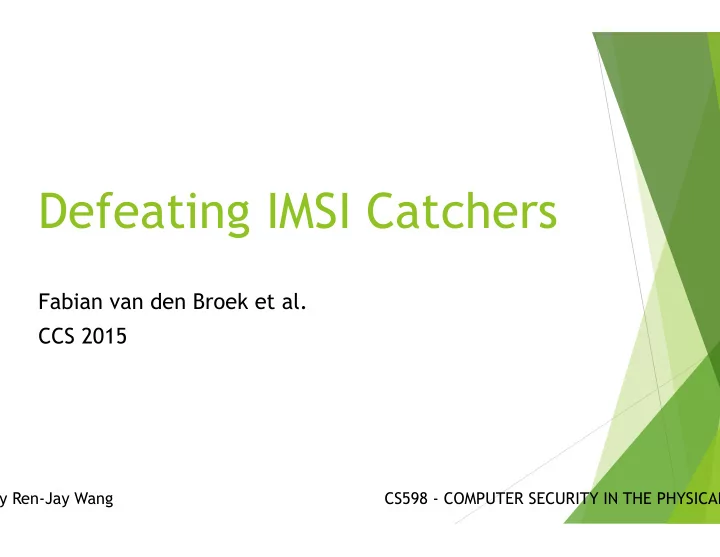

Defeating IMSI Catchers Fabian van den Broek et al. CCS 2015 By Ren-Jay Wang CS598 - COMPUTER SECURITY IN THE PHYSICAL
Background – 3GPP 3GPP – 3 rd Generation Partnership Project Encompasses: GSM and related “2G” standards • UMTS and related “3G” standards • LTE and related “4G” standards •
Background – 3GPP Identifiers International Mobile Subscriber Identifier (IMSI): 15 digit number; main identifier and belongs to one SIM card Temporary Mobile Subscriber Identifier (TMSI): Temporary pseudonym provided to protect against traceability attacks; updated when phone moves to a different region International Mobile Equipment Identifier (IMEI): 15 digit number that identifies the phone – used to counteract phone theft
3GPP Protocol Overview Identification Cell towers broadcast identifiers • Mobile phones look for certain networks using • Mobile phone requests a channel • Cell tower sends requests, including SIM ident • Mobile phone sends response •
3GPP Protocol Overview Identification Cell towers broadcast identifiers • Mobile phones look for certain networks using • Mobile phone requests a channel • Cell tower sends requests, including SIM ident • Mobile phone sends response • Authentication • Symmetric Key Encryption • Sequence Number to combat replay attacks
3GPP Protocol – Authentication Details Authentication and Key Agreement (AKA) protocol Roaming taken care of through split between home and serving networks Home network sends a random number (RAND) as a challenge, along with the corresponding response, keys, authorization token (AUTN) and sequence number SIM checks authentication, checks sequence number, then computes response and sends to serving network.
So what’s the problem? IMSI Catching attacks – Passive attacks observe traffic and store IMSI, and active attacks set up a fake base station (similar to a MITM attack) Why do we care? IMSI transmissions leak your approximate location, leading to monitoring or tracking attacks Underlying problem: use of symmetric cryptography means there needs to be an identification phase before mutual authentication Previous solutions: randomizing, encryption
Proposed Solution New variable: Psuedo Mobile Subscriber Identifier (PMSI) During authentication, server provides SIM with new PMSI SIM uses PMSI next time it identifies itself Server and SIM need to store new secret key, current PMSI and new PMSI
Proposed Solution – 2G No network authentication, no sequence numbers Add sequence numbers to the solution, and accept a larger set of SQN values to prevent replay attacks To prevent faking the base station (active attack), the server has a cryptographic MAC using a secret key. Cryptographic MAC also prevents DoS attacks forcing the sequence numbers out of sync
Analysis – How does the solution perform? Passive attacks – stopped because the use of changing pseudonyms Active attacks – stopped through the use of secret keys MITM - still there Traceability – better than current use of TMSI, as switching PMSI will refresh TMSI PMSI still reveals home country and home network – k -anonymity All necessary variables fit in the current space Challenge is 16 bytes (128 bits) • 34 bits for PMSI • 48 bits for SQN •
How easily could it roll out? Don’t swap the SIMs – Update them remotely! Backwards compatible Low computational overhead Small overhead for serving network because SIM switching to new PMSI will look like a new phone Proverif shows that new system has unlinkability & authentication given that the cryptography doesn’t break
Summary First work combatting IMSI catching in 3GPP networks Use of changing pseudonyms (PMSI) for identification Unlinkabiltiy and authentication Easily deployed by service providers
Discussion What are the main advantages to this approach? Do you think the defenses provided are sufficient? How relevant is this paper today? What limitations does this paper have?
Recommend
More recommend